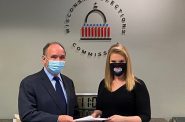Three Ways to Reduce Violence in the City
Milwaukee could learn from a project that cut crime by 62 percent.
How do we deal with Violence in Milwaukee?
Violence, particularly, gun violence has increased throughout the country and has become a problem in the City of Milwaukee.
Some may look at this as a regular occurrence in the city while others plunge into somewhat complicated and historical theories, statistics and rationales.
I have three suggestions on how to deal with it.
First, ignore it. Yes, ignore it. Most Milwaukee residents ignore it anyway. They may talk about it at work or on the internet briefly however, in my opinion, it is only a few people who actually believe the “sky is falling.” Milwaukee residents discuss the annual summer violence with friends, family and neighbors for a few minutes just like a casual conversation about the weather or our beloved Packers. However, most of these casual discussions end up with a “too bad, but it’s not my problem.” Only people who are immediately affected or who really care enough get into a solution oriented conversation.
So we can just ignore it and pay for it with the loss of our youth and the cost in the loss of lives and productivity and depreciation of property and people.
Second, we can work with people who want to see and also (most importantly) believe in change. Communities need to know what options are available in making their community safe. First, working with the police department is important. Here are few steps anyone can take:
- Call the police when you see suspicious activity with specific details, names, descriptions, addresses and activity.
- Start a block watch when you can and meet at least, once a month.
- Report problem properties often.
- Make sure you have porch lights and addresses on your home or others you own.
- Report any licensed establishment to the local alderperson and the license committee.
These five items will decrease crime in your neighborhood significantly.
If you have mostly renters in the neighborhood, you can still report and organize, just work with the landlords via the City of Milwaukee and your local alderperson.
Third and lastly, we as a community could actually work with the people who are causing the problem. We need to get the message out to the purveyors of this culture of violence.
A strategy that we could employ is the marketing concepts that are apart of the Montana Meth Project led by billionaire Tom Siebel. It is and continues to be a very focused, funded and genuine project that has changed lives.
Since the Project’s inception in Montana in 2005, teen Meth use declined by 63 percent, adult Meth use dropped by 72 percent, and Meth-related crime is down 62 percent. The Meth Project has been adopted by seven additional states with similarly encouraging results.
The Meth Project used prime time, graphic advertising on television and radio, Here is one of my favorite advertisements from the Montana Meth Project.
In addition, local artists were employed and worked with local communities; 1,000 artistic creations with similar messaging was installed across the state.
Imagine if we replaced the meth prevention with an anti-violence message? First, it would be amazing to find anybody (especially from the black community) with such a financial commitment as Mr. Siebel. Second, it would be amazing to see such dramatic decreases in homicides in Milwaukee.
The Meth Project used in-your-face, graphic and frequent images. In the process they did not blame culture, parents or government. We need a similar approach to violence in the City of Milwaukee. We need frequent, nonstop, in your face graphic images aimed at children and young adults. However, these images should be backed up with solid ways of handling tense situations and occurrences that lead to violence.
For example, if I had funding for such an initiative in Milwaukee, I would fund church groups who could organize youth groups between 20 and 40 teenagers. These groups would visit local communities who have been recently affected by violence and the charge would be for these groups to pass out literature, connect with stakeholders about resources and even protest in silence, similar to the pro-life movement, using signage with an anti-violence messages.
We have been able to change minds concerning smoking, abortion and gay marriage in just one generation. I believe, if we wanted to we could change minds about violence in this community.
So when dealing with violence in Milwaukee, it is not a question of if we can do anything about it. It’s a question of whether we care or not about the children of this community and the future of this city.
Keith Stanley is the executive director of Avenues West Association/BID #10.
Op-Ed
-
Why Vote for MPS Funding Referendum
 Mar 30th, 2024 by Nehemiah Edwards
Mar 30th, 2024 by Nehemiah Edwards
-
Wisconsin’s Very Own Rudy Giuliani Should Not Oversee Judicial Ethics
 Mar 25th, 2024 by Richard Niess
Mar 25th, 2024 by Richard Niess
-
Voting at Wisconsin’s Universities Isn’t Easy
 Mar 17th, 2024 by Nicole Laudolff
Mar 17th, 2024 by Nicole Laudolff


















Too many people in this city protect the criminals, drug dealers, and bad guys. The inner city can never fully improve unless people there start cutting ties to poisonous element that is given safe haven. Need more mature, adult men taking these young kids under their wing and getting them the hell away from the criminals.
Easier said than done. 60% of the stuff you could call in, they’re gone by the time you get to an operator.
Don’t get me started on how difficult it can be to get through the “specific details” part of this with the various operators that take these calls — MPD places a huge burden of proof on the caller.
I know they need to get accurate information to help prioritize their limited resources.
The biggest problem is being left with the feeling of “Fine, I did my part, but now nothing will happen”. Especially if they leave and you call back to cancel the call. Does that cancel the report altogether and wipe it from MPD statistics that would over time indicate problem areas or properties? So many questions…
I am confused by the first point in Mr. Stanley’s op/ed, re: “Ignore it”. I have read it a couple of times. Is it just me, or is the point (whatever it is) not very well made?
# 4 and this should be # 1. Realize Milw. this is a sin problem not a social problem. Man’s heart is evil and only God can change you. I am saddened to see that pastors of this city have not taken this as a challenge to boldly proclaim the gospel of Jesus Christ to our state. Do you really believe that mere man will solve this problem? If you do you live in a la la land of make believe. Show me any state in the union that has been able to stop the murder of it’s people? I’ll wait.